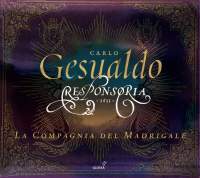Texte paru dans: / Appeared in:

Early Music Today (06-08/2014)
Glossa
GCD922803

Code-barres / Barcode : 8424562228030
(ID402)
Consultez toutes les évaluations recensées pour ce cd
~~~~ Reach all the evaluations located for this CD
In the Christian calendar there is no event for which believers are more ineluctably prepared than Easter. Passion Sunday, Palm Sunday, Holy Wednesday, Maundy Thursday, Good Friday, Holy Saturday: this procession of eventful days heightens the agonising expectancy for Easter Sunday with its outpourings of joy. On Thursday, Friday and Saturday of Holy Week, the offices of Matins and Lauds ‑ with their three nocturns of readings, antiphons, psalms, versicles and responses ‑ are celebrated together as Tenebrae. Carlo Gesualdo’s 1611 collection of six‑part settings of the responses have long been regarded as the emotional height of his sacred music: they were published in the same year as his sixth book of madrigals, also full of expressive extremes, and only two years before his death, when he is known to have been suffering from poor mental and physical health.
On their
recording (repackaged from a 1997 release) Andrew Parrott and the Taverner
Consort have created an aural reconstruction of Tenebrae for Good Friday,
complete with the requisite portions of plainchant interspersed between
Gesualdo’s settings. Parrott’s all‑male ensemble sing the polyphony one tone
lower than published, giving
their performances a rich, burnished sound ‑ and the countertenors have no
problems with the numerous Fs and Gs at the top of the stave.
The Italian vocal 'super‑group' La Compagnia del Madrigale have also recorded the aforementioned madrigal book for Glossa, and for this recording of the complete Responsoria they present Gesualdo's settings not in the context of a liturgical service, but with the nocturns separated by spiritual madrigals by that composer's contemporaries (de Macque, Luzzaschi, Marenzio, and Vinci; a motet by Stefano Felis rounds off the whole recording). This makes these discs feel more like a concert than a devotional occasion, and as a result, the listener doesn’t feel drawn along the road to Calvary by these slightly cooler performances.
With
sopranos singing the top lines, La Compagnia perform the pieces at their
printed pitch, which leads to occasional shrillness at the points at which
Gesualdo’s spacing of the voices is greatest ‑ both of these recordings are
one‑voice‑per‑part, but the solidity of Parrott's lower voices (even at the
lower pitch) means that on his recording, these moments are completely
secure. In addition, as beautifully sung as each piece is by La Compagnia ‑
the madrigals in particular, in which the ensemble's native Italian gives
sparkier textual delivery ‑ the unchanging chain of polyphony can lead the
mind to drift somewhat from the original intention of these texts, whereas
the juxtaposition of chant and polyphony by Parrott and the Taverner Consort
ensures that ones mind and thoughts are kept firmly focused on the
inevitable destinations of this Lenten journey: a hill, a cross, an empty
tomb.
Fermer la fenêtre/Close window
Cliquez l'un ou l'autre
bouton pour découvrir bien d'autres critiques de CD
Click either button for many other reviews


